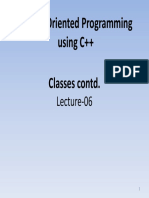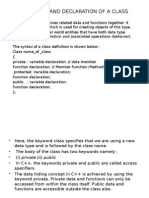0% found this document useful (0 votes)
6 views21 pagesC++ - Unit 2
The document provides an overview of classes and objects in C++, explaining the concept of user-defined data types, member data, and member functions. It details access specifiers (private, protected, public), object creation, member function definitions, and the use of static members and friend functions. Additionally, it includes examples to illustrate these concepts and their implementation in C++ programming.
Uploaded by
jaynthir01Copyright
© © All Rights Reserved
We take content rights seriously. If you suspect this is your content, claim it here.
Available Formats
Download as PDF or read online on Scribd
0% found this document useful (0 votes)
6 views21 pagesC++ - Unit 2
The document provides an overview of classes and objects in C++, explaining the concept of user-defined data types, member data, and member functions. It details access specifiers (private, protected, public), object creation, member function definitions, and the use of static members and friend functions. Additionally, it includes examples to illustrate these concepts and their implementation in C++ programming.
Uploaded by
jaynthir01Copyright
© © All Rights Reserved
We take content rights seriously. If you suspect this is your content, claim it here.
Available Formats
Download as PDF or read online on Scribd
/ 21





























































